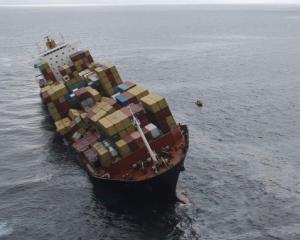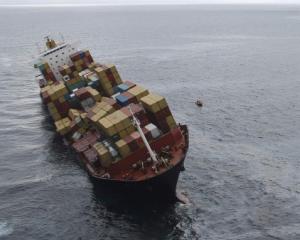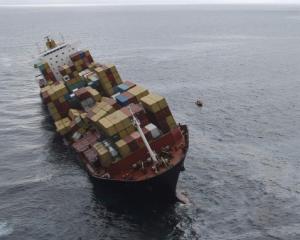Nearly a third of the oil on board grounded vessel Rena has been pumped off the ship.
Salvors had extracted 481 tonnes by 3pm yesterday, but this morning the figure was closer to 500 tonnes after overnight pumping efforts said Svitzer spokesman Matthew Watson.
Maritime New Zealand (MNZ) salvage unit manager Bruce Anderson said about 870 tonnes is still onboard, in four different tanks.
Salvors have been pumping the port number 5 tank, which originally held 772 tonnes.
Mr Anderson said two booster pumps installed on Sunday afternoon had sped up the pumping rate from the port tank, and Svitzer's salvage teams were continuing to work on ways to extract oil from the submerged starboard tank and two settling tanks in the engine room.
The salvors loaded more equipment on the ship yesterday afternoon, including a lighting system.
"This is important, because they have been working in dark, oily corridors, which is clearly risky and challenging,'' he said.
"The lighting will make the working environment safer for the teams on board. They have also loaded heavy duty compressors to aid the pumping system.''
Mr Watson said the continuous pumping efforts was positive but the ship was still dangerous and on a severe list and was dangerous.
"She's still creaking, she's still groaning. No one can rest on their laurels and assume everything is fine,'' he told Radio New Zealand.
The on shore incident command team is planning for any impact on the shoreline from the oil that leaked from the ship on Saturday night.
National On-Scene Commander Rob Service said planning teams were continuing to track the movement of between 5 and 10 tonnes that leaked overnight Saturday.
"While this is a relatively small amount of oil, it is the most significant amount released since the major spill on 11 October,'' Mr Service said.
"The slick remains around the vessel for now, but our current modelling suggests it will move slowly north from Wednesday and possibly reach the shoreline of Tuhua/Mayor Island on Thursday.
"We have sent a team of wildlife experts to the island to assess what we can do to protect wildlife if we get some shoreline impact there in the next few days. The team is working with iwi, who own and care for the island, as local expertise and knowledge is hugely valuable.''
Mr Service said the team would assess what likely response options were available to them and report back to the wildlife team in the incident command centre.
He said the trajectory modelling was difficult, as the conditions on the water were very dynamic.
"We will continue to track the slick with observation flights and on-water surveillance as well. It is spread very thinly and this will help break up the oil over the next day or so.''





